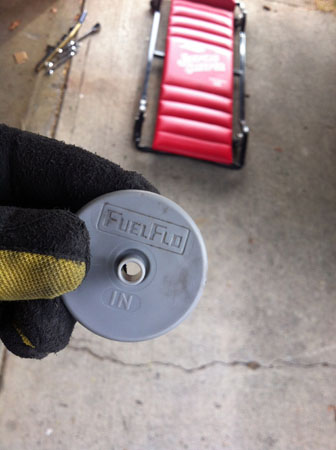Toyotie Modfest
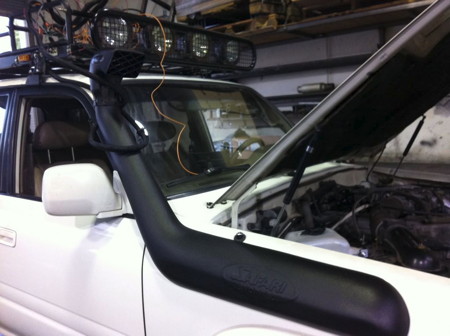
Having accumulated several parts kits for the Land Cruiser, I was planning to install them on an upcoming weekend. Lumping the related kits together, there were three basic groups:
- An IBS dual battery kit. This would be installed along with a second factory battery tray, and Slee’s washer bottle relocation kit. Of course, there would also be a second battery to complete this installation.
- A Safari Snorkel kit.
- An ARB high-output compressor. I didn’t need it for running lockers, but it would be very useful for airing up tires. Unlike my PowerTank, the compressor wouldn’t surprise me by suddenly running out of CO2. I also had a mad idea that if I got a compact enough Odyssey battery, the compressor might also fit inside the second battery tray alongside it.
I’d not installed anything like these three items before. None of them looked too intimidating, but they were all fairly involved and would surely take a lot of time, perhaps a full weekend or two.
When the snorkel, battery tray and washer bottle relocation kits arrived from Slee, I started thinking about when I could do the install. Just as I was about to schedule things, something came up to completely disrupt my plans. Of course.
I happened to drop in and take a look at the Classifieds on the IH8MUD site, and saw a fresh post offering an INTI roof rack for sale. These were pretty rare things, and in high demand. I’d only seen one come up for sale in the previous few months and it sold immediately, with a long queue of would-be buyers left out of luck… I checked and this listing had just been posted, and it turned out the seller was even nearby, only about a half hour drive from me.
I checked everything out quickly, twice. Everything checked out. I knew that this was a rare opportunity, so I pounced. I contacted the seller and told him I’d take it, along with the HID lights mounted on it. I knew this would torpedo my build budget for the next month or two, but sometimes you need to strike while the iron is hot, or you miss your opportunity.
I was a little crestfallen when the seller got back to me to let me know I was actually second in line. Someone else had gotten to him first. He said he’d be in touch if the deal fell through for some reason… I thanked him and wished him luck with the sale, and asked that he definitely let me know if it didn’t work out… Damn.
To my surprise, a day or two later came word that the rack and lights were mine if I wanted them. Woohoo! I made arrangements to come check them out on the weekend. I pulled off my old rack, made the drive up to Fremont early that Sunday afternoon, and after a couple of hours was home in my driveway with a new – to me, anyway – INTI rack on Toyotie.
I’d considered a couple of other racks – mainly ARB and Baja Rack offerings – as well as keeping the INTI-inspired homemade rack that had come with the Land Cruiser when I bought it, but the Venezuelan-made INTI was my favorite rack option. I just couldn’t be sure I was ever going to get my hands on one. It complicated my build plan because getting the rack finalized was a prerequisite to getting some other things (like the various rack lights) done.
Now that I actually had my dream rack, I was free to proceed with those other items. These were simplified somewhat because there were already four 7″ HID lights in place on the rack. Now I didn’t need to go buy a set of lights myself. Also, the previous owner had put in place some other touches in the form of amber LED sidemarker lights, red LED rear lights, and an amber flashing light on the center-rear of the rack. These were all nice touches, although it meant that I’d need to get a lot of proper wiring done. Also I was going to move the Land Rover work light over from the Jeep, so there was some more wiring to be done.
So now I had a list of rack-related items, in addition to the other list I’d started with, and probably more than double the amount of work. Some of that work, like the ARB compressor and the snorkel, was going to be totally new to me… So after dwelling on it for a while, I decided that in order to get everything done (and done right) I’d break down and take Toyotie into the shop and have them do it. I’d pay for that option – literally – but it would be done in a day or two instead of a month of weekends, and it would be done by experienced pros, and not an enthusiastic hack like me.
There was an additional complication, which was that my original battery didn’t seem to want to hold a charge anymore. I suspected a bad parasitic drain, which seemed to be getting worse over time. I absolutely needed to identify and put a stake through the heart of that problem. Again, this was something I wanted an expert opinion on.
And so it was done. The photo gallery has pictures of everything and captions with all the gory details.
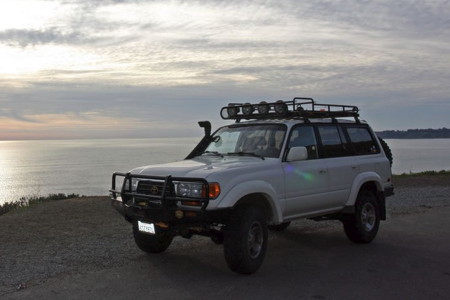
Do You See the Light?
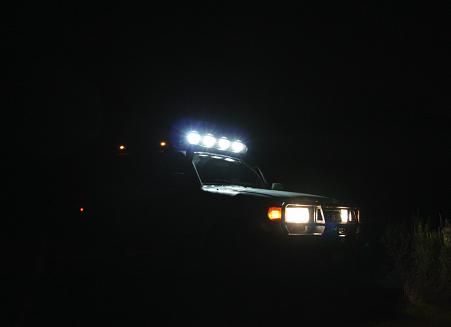
I’ve just had a lot of work done on Toyotie after buying a new (to me) INTI roof rack. Lots of wiring mainly, but also I had a few other things installed at the same time. I’m working on the writeup and photos, but until that’s done I have another small gallery from this weekend.
I wanted to check out the new HID lights that came with the roof rack and get an idea of what they were like. I knew they were cheap HIDs (Kragen 7″) but I’d not had any HIDs before, so I wanted to see what sort of light these things threw.
As it turns out, these things are really, really bright. The throw isn’t as far as I thought it would be, but that may just be because of where they are aimed. I think I need to point them further out… Or at least one pair further out. It looks like I’ll have to park somewhere after dark where I can take my time and play with the adjustments and see what makes sense.
In the meantime, here’s a small gallery of photos comparing the lights on Toyotie as they currently stand.
Yosemite via Offroad… In January?
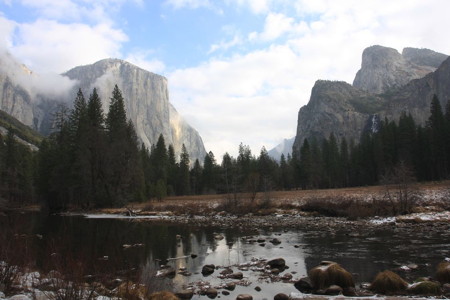
A week after our return home from Death Valley, I was still buzzing from the trip. It had been an adventure, and I had already starting thinking about “Where do we go next?”
I started making some notes on my calendar, updating the list of company holidays, and I noticed that one was just around the corner: MLK Day. That would give us a three-day weekend to do something with. I started thinking of where we might go, and browsing some of my guidebooks. A plan quickly formed.
If we stayed overnight on Sunday night (not a problem with the Monday holiday), there was room available at the Ahwahnee in Yosemite. Because of the cost(!) and the popularity of the hotel, we’d never stayed there. But it had been something that I’d wanted to do for several years and this seemed like a good opportunity.
The next step was looking through some of my trail reference books. From those, I was able to identify a 30-mile offroad route into Yosemite that looked promising. I had been into Yosemite via the three most common routes I was aware of: Highway 120 from the west, Highway 120 via Tioga pass from the east side, and Highway 41 from the southwest near Wawona. I knew of the Hwy 140 entrance as well, but had never heard of a dirt road into the park. That was something of a dream combination as far as I was concerned.
In the Northern California “Massey book” (starting on page 226) this road was described as a collection of various forest service roads, winding along wooded Sierra mountainsides, on the Old Coulterville-Yosemite toll road, which was the original road into Yosemite Valley. It would normally be closed this time of year due to snow, but with the unusual dry weather this year it might yet be open. Since even the road to Glacier Point was still open – which was pretty unheard of – it was worth a look.
There was another important consideration in this trip, and that could be summed up as compromise. That’s often a key factor in family outings. Carrie and Allison had enjoyed the Death Valley trip, although both of them are somewhat less enthusiastic about “roughing it” than I am. This trip would get me to Yosemite – maybe my favorite place on Earth – and also I’d get a few hours of offroading in too. Score! But from their perspective, we would get to stay in a luxury hotel for the first time, really. We’d have fun in Yosemite, and I’d intentionally avoid any big hikes or other physical challenges for a change. We’d do the tourist thing, browse the gift shops and visitor center, have a couple of nice meals and generally take it easy for once.
I wanted them to share my enthusiasm for our family road trips in Toyotie, and not dread them. So this short trip was designed to make everyone happy, and in the end it was a complete 100% success. It seems that compromises don’t always have to be painful, as ours have sometimes been in the past. Maybe I’m slowly getting smarter about these things.
We left Sunday morning and drove up to Coulterville, a historic little town right out of the Old West. I’d been there a few years back with Antony while we were on our way to the GBES Navigational & Geocaching Rally in Nevada. It’s not much more than a wide spot in the road but it’s packed with several historic old buildings, a pioneer cemetery, etc. From there it was something like seven miles to the start of the Old Coulterville Road, and the dirt.
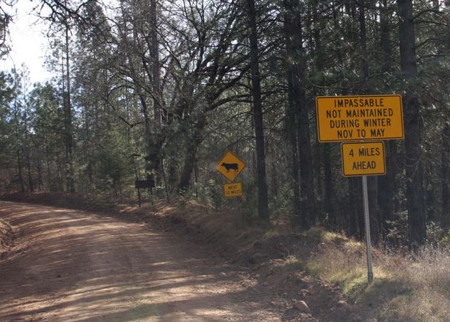
We reached the trail and I was happy to find the gates standing open, and no evidence of snow. There were warning signs about the trail being impassable and unmaintained starting in November, but that would be in a normal year, which this surely was not. My main concern throughout the 30-mile drive was that we could be halted at any time by gates, rockslides or washouts, or fallen trees. As it turned out, we saw evidence of all of these hazards along the way, but fortunately none that stopped us.
The road was a fun drive and very pretty along the entire route. As we were a solo vehicle in a remote area, I took it easy and paid extra care to avoid any hard hits that might cause a flat or other damage. The trail was mostly easy, but was sometimes rocky or badly rutted. There was one spot where a large tree had fallen on the downhill side of the trail, and its root ball had taken a very large bite from the trail. We’d have to winch ourselves out if we fell into that, and it would surely involve body damage. I had Carrie get out and spot me while I got the wheels up high on the uphill side of the trail. She said I squeaked past with about three inches to spare.
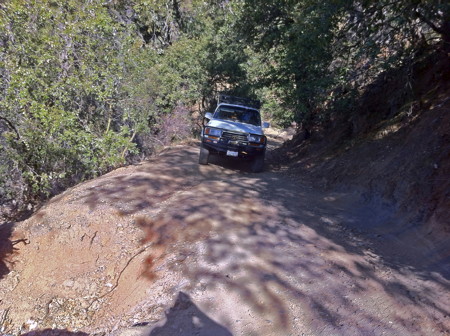
Along the way there were a few scattered fallen trees, but these had been cut by chainsaws or only covered part of the trail. The trail did narrow in places, with encroaching trees and brush that scraped at the roof rack and the CB antenna. At times I had to pick a line and squeeze through the brush while also accounting for the trail surface and ruts.
I navigated the numerous trail intersections and offshoots carefully, following the route I had created in my mapping software. Some of the side trails were gated, and most of those gates were closed. Some of them were ones I had identified as potential “alternate exits” back to civilization, so I was a little concerned to see our options dwindling as we went. I hoped that the main trail would remain open or we might face a lengthy backtrack.
We encountered only one other vehicle on the entire drive, an older Tacoma going the other direction from us. They may have been hunters. Nearing the end of the trail at Foresta, we encountered a group of hikers at the waterfall where I had to drive through about thirty feet of the waterfall’s runoff. Then as we reached the end of the dirt road in Foresta, we saw that the bridge there was closed! Dire signs warned against any attempt at driving over it. Thankfully, our luck held and we had a quick alternate road available to another bridge that was open.
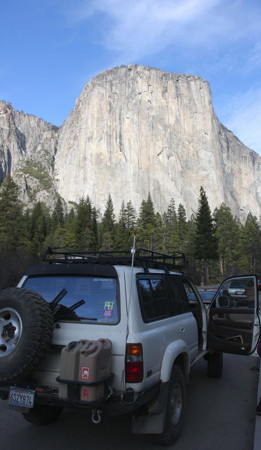
From there we quickly reached 120/Big Oak Flat Road, ate lunch at Half Dome View, and then drove into Yosemite Valley amid the usual “ooooh” and “WOW” sounds. It had been a few years since Carrie had been to Yosemite and I think it was Allison’s first time. She was thrilled to be able to play on some old snow and iced-up streams before we made our way to Yosemite Village and then finally to the Ahwahnee.
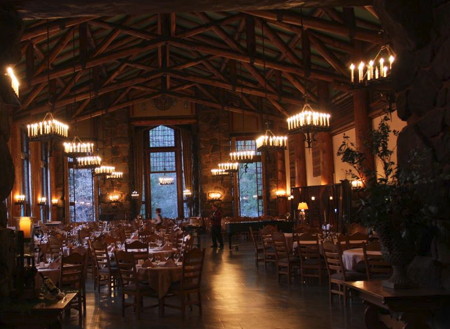
Our stay at the hotel was perfect and we enjoyed everything thoroughly. The Ahwahnee is a beautiful and large lodge, which also served as the inspiration to the large hotel in The Shining movie. I loved the old wood beams, fireplaces, and the grand lodge feel of the place. We ate dinner (and breakfast the next morning) at the hotel’s equally-expensive but very nice restaurant. The food was great and I actually enjoyed getting “dressed up” for it. Allison behaved perfectly, which is something of a rare thing when eating out, and that pleased us to no end.
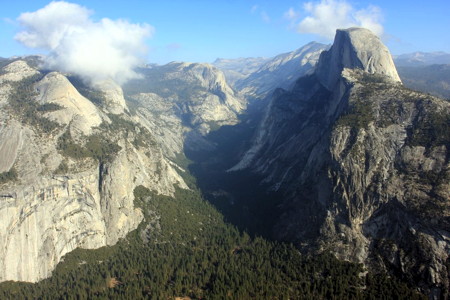
We reluctantly checked out after breakfast on Monday morning and drove through the valley, making the obligatory stop at Tunnel View before driving up to Glacier Point, a wonderful and unprecedented treat for mid-January. There was some snow around but not much and the road was almost completely clear, especially on our return trip where the sun had cleaned it off. Glacier Point was just a little brisk and fog blew through the southeastern end of the valley, but otherwise the weather was splendid and I marveled at our good fortune.
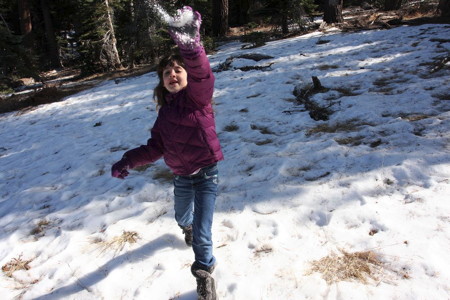
We drove back to the valley – stopping to photograph a roadside coyote – and had lunch at the deli before picking up an inexpensive print at the Ansel Adams gallery, and began the long drive home. Sometime close to sunset we stopped at the huge and wacky Bass Pro shop in Manteca, gawking at the high ceilings, waterfalls into a large fish tank, and other unusual wonders. It’s a bit like the “Red State” version of an REI crossed with a theme park. It was a great excuse to stretch our legs, and from there the rest of the drive home was certainly pretty dull in comparison.
We made it home without incident, covering 450-miles over the trip, nicely within Toyotie’s 500-mile range. It had been an absolutely perfect two-day family getaway, for which we were grateful.
The next weekend, the late snow finally arrived and closed Glacier Point Road and others, almost certainly including the Old Coulterville Road. We’d just squeaked by at the right time!
…..
Editorial note – As I worked on this post, I learned of a rockslide in Yosemite from the Yosemite Conservancy’s Facebook page:
“Due to an overnight rockslide, the Big Oak Flat Road is closed from the Foresta Road junction to the El Portal Road junction. There is currently no access to Yosemite Valley from Highway 120. The rockslide has caused major road structural problems; a complete assessment will be made later today and more information will be subsequently provided. The road is closed indefinitely.”
Happily, the damaged section of road is scheduled to re-open – with a temporary stretch of gravel – this weekend.
Death Valley: Debrief
Recapping, our complete trip totaled 1,250 miles. 450 of those miles were within the boundaries of Death Valley National Park, according to the maps I used. (Note that the park boundary on the west starts way out in Panamint Valley.) We spent a total of 130 miles on dirt.
Our drive from Stovepipe Wells to Titus Canyon to Homestake camp was about 100 miles. Returning to Stovepipe Wells from Homestake (backtracking to Ubehebe Crater etc.) was about 71 miles. Because our driving speeds were so moderate throughout the drive, we experienced better than normal gas mileage as well. YMMV!
Approximate driving distances*
Hampton Inn Suites in Ridgecrest to Stovepipe Wells: 100mi.
Stovepipe Wells to start of dirt road to Titus Canyon, off Hwy. 374: 28mi.
Titus Canyon drive, from Hwy. 374 and ending at North Hwy. pavement: 27mi.
Titus Cyn. dirt road exit/North Hwy. pavement to intersection with Hwy 267 to Scotty’s Castle: 19mi.
North Hwy/267/Racetrack Valley Rd. intersection to start of Racetrack Valley Rd. dirt near Ubehebe Crater: 6mi.
Racetrack Valley Rd. start to Teakettle Junction: 20mi.
Teakettle Junction to Homestake Camp: 10mi.
Stovepipe Wells to Wildrose campground: 31mi.
Stovepipe Wells to Furnace Creek: 25mi.
Furnace Creek to Badwater Basin parking lot: 18mi.
Badwater Basin parking lot to southern intersection of West Side Road: 26mi.
Full length of West Side Road: 36mi.
* All distances rounded up for simplicity & for conservative planning.

Just a few of the many resources used for planning our Death Valley road trip.
Observations & Lessons Learned
1. It seems that we narrowly avoided a disruption to our trip in the form of the reported power outage at Stovepipe Wells. I’m not sure how widespread the outage – which lasted a few days – was. If gas was also unavailable at Furnace Creek then it would have definitely been a major inconvenience. Lesson learned: while gas might be unavailable where planned for a variety of reasons, it’s probably more likely to happen in remote locations like DV.
2. Speaking of gas shortages, losing the aux tank fuel pump also lost us half our onboard fuel capacity, which I’d been using as a reserve. It was still available via my siphon in an emergency, but my lesson there is that it’s better to have fuel in the main tank than the aux tank.
3. The weather was pretty nice when we were in DV, but cold (mid-30s) overnight at Homestake. Someone who was there the following week reported an overnight low of 18F. When car camping, the best bet is to bring too much cold weather gear than too little, at least during the winter.
4. We ran our SPOT Connect throughout the trip and overall it performed well. Battery life was well beyond what I had anticipated, using lithium batteries as directed. However, the SPOT interface is still a bit flaky and we drove around for most of a day without the automatic tracking on like I thought it was. With no data/internet connection for the mobile devices, it wasn’t possible to check the SPOT tracking page to verify that things were working as expected. Overall though it has worked very well for us.
5. Next time I will pre-load offline maps into MotionX GPS HD on the iPad 2. Trying to cache MotionX maps (in GPS HD or Drive HD) when I had a data connection was not at all reliable or effective. In any case, my good old-fashioned paper maps came in handy.
6. Overall, our gear worked very well. Tent, sleeping bags, kitchen kit, tools, etc. all performed as expected. I did forget to bring the tire chains, although it turned out that we wouldn’t have used or needed them anyway.
7. I did note that our typical road trip pattern – driving around all day and camping overnight – was a serious obstacle to static solar power generation. Heavy dust would have been an issue for mobile solar generation too, and along with washboard road battering may be detrimental to the longevity of expensive solar panels. But solar power generation is most likely to be needed in a longer-term static campsite, like when we’re at OX12.
8. Lastly, Death Valley is amazing. I’m not a huge fan of broiling temperatures, but even the deserts have seasons and I planned our visit accordingly. There’s a lot to do and see in the park and the whole family had a total blast. I’m looking forward to visiting again and exploring more.

……
And about that fuel pump incident… I’m still not sure what caused it. The most obvious possibility is that a rock was kicked up, or a root or branch, and the pump or the fuel line was pulled and the end piece came out. I would have thought the pump and lines were pretty well protected, but a lot of rocks were kicked up on this trip, so it’s certainly possible.
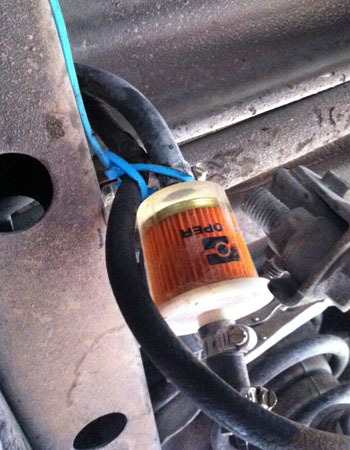
The fuel filter unit. Ain’t it cute?
Another thing I thought of was that the end piece could have been pushed out with pressure. The fuel system on these things create a pretty strong vacuum and then when the fuel suction decreases, it can cause the aux tank walls to “BONG” out again. Perhaps that that kind of pressure change could pop out the plastic end piece.
So, what to do? First off, I repaired the fuel pump myself. I popped the end piece back on using two small clamps and hand-tightening each until the end piece popped back into place. It’s worked fine ever since, with no leaks. I’ve been using and closely monitoring it to be sure, and it handled our recent Yosemite trip (30 miles of offroad) with nary a glitch.
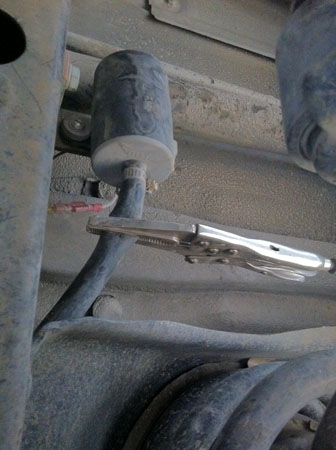
Fuel pump with the one end cap still off and vice grip improvised clamp.
I think that if I can get a good tie-down of some kind to stay on the barrel-shaped pump, it would help prevent a recurrence. Also, I’m going to zip-tie some pipe insulation around the pump as padding from rock strikes. I will also look into reducing the fuel system vacuum, if appropriate. I believe that Toyota does say that the factory fuel cap is designed to reduce that. Lastly, I’ve zip-tied the pump and lines so they don’t hang down as much as they used to. Hopefully one of those improvements will be the silver bullet. Time will tell.
I did note that both issues we had in Death Valley – the fuel pump and the battery cable coming off the post – were not issues I could blame on Toyota. It was an aftermarket auxiliary fuel pump, and my failure to tighten the battery terminal bolt sufficiently after I had loosened it.
Lastly…
